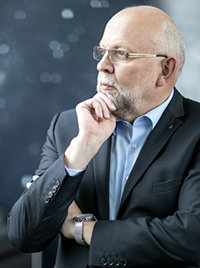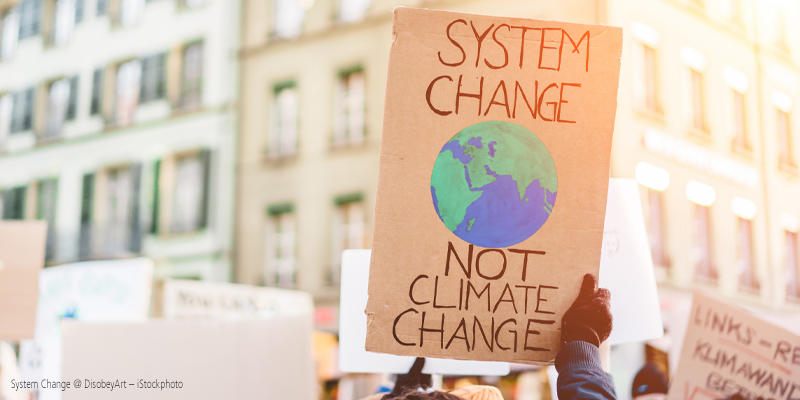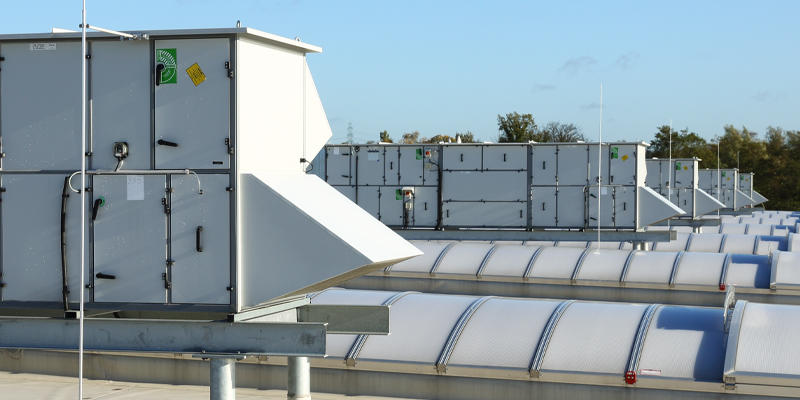He is a renowned expert in air conditioning technology and has also contributed to its further development: As Director of Innovation and Technology, Hermann Ensink understands the demanding interplay of technical and atmospheric climate.
He tells this story, which is very indicative of the way in which Hermann Ensink approaches the solution to a problem. Together with the then Managing Director and today Managing Partner Heinrich Kampmann, he was sitting over a beer in 1993 in a hotel lobby after a long day at a trade fair and musing about how unit heaters could be both functional and stylish. He had a sudden inspiration and took a beer mat and sketched a hexagonal unit heater – this was the birth of the Ultra, which went on to become one of Kampmann’s biggest successes. Of course, not all the qualified engineer‘s ideas always come to him over a beer after work. But many of his product developments demonstrate that he always takes into account the demands of the market coupled with current technical trends. Some 25 years ago, it was Hermann Ensink who proposed that Kampmann products should provide cooling as well as heating. So over the course of his 40-year tenure at the company, he really has helped to shape the future of Kampmann.
Mr Ensink, it’s clear that I need to speak to you about the indoor climate of buildings. In recent years, you have certainly come into contact more frequently with atmospheric climate …
At Kampmann, everything revolves around the topic of ‘climate’ – it means everything to us and me in particular. However, you can approach this topic in different ways: firstly technically. While I was studying, climate essentially meant four thermodynamic functions: heating, cooling, humidification and dehumidification. Experts are still talking today about the correct definition, although its general use in language has long superseded this discussion. Climate is also a byword for how a person perceives his environment. And so it is with good reason that, as building services experts, we are very concerned about the climate in buildings. It is interesting to note that the focus is changing in terms of building climate: previously the focus was on heating, while now is it more on cooling and ventilation. And to come back to your question: Yes, last but not least, the word has become very current and relevant for society in the course of the debate about climate change.
Greta Thunberg is striking for the climate with “Fridays for Future“, while the Greens are achieving record results in elections. Should the air conditioning industry in particular not be proceeding proactively, instead of just responding to laws and regulations?
Definitely, the industry could do a lot more. Recently climate change is creating a ‘change of climate’ as it were: global warming is forcing us to rethink air conditioning in buildings and consider renewable energy sources.
As it happens, in the summer of 2019, we reached the highest temperature ever measured in Germany in Lingen: 42.6 °C. In the face of this kind of heat, should cooling not be becoming a mega-trend?
It is. Air conditioning systems in cars, in public buildings, shopping malls, supermarkets and hotels are now a matter of course. But that‘s not always good for our global climate. The simple machines in particular are extremely harmful. Air conditioning is somewhat twofaced: on the one hand, it ensures the wellbeing of people, while, on the other hand, it jeopardises the environment from the F-gases that can escape from smaller air conditioning units.
A bitter irony: the summers are getting warmer and the demand for cooling in buildings is rising. To do so, we are using a refrigerant that accelerates global warming. Is the air conditioning industry aware of this vicious circle?
In Europe there is increasing understanding of the fact that we need to provide cooling in the most natural way possible. However, that is not yet the case particularly in the Far East and on the other side of the Atlantic. There some buildings are over-cooled and systems are installed that use extremely environmentally harmful refrigerants. If a kilogramme of R410a were to escape from one of these refrigerant systems, this would have the same potential damage to the environment as a 32,000 kilometre journey in a mid-sized car. If you add desolate installations to this, there is massive potential to reduce F-gases.
The F-Gas Regulation is gradually restricting the production of refrigerant damaging to the climate. How is the HVAC industry responding to this?
The regulation is a blessing for the climate and industry alike. It forces us to use natural cooling methods and refrigerants, like water or R32. However, the latter is combustible. Therefore, we advocate only using refrigerant in outdoor equipment, say in chillers. For instance, not a lot can happen if they are installed on the roof. Cooling – and possibly also heating – is then distributed by the safe heat carrier – water. Our customers get on really well with this technology. Its use is generally even more cost-effective if you integrate free cooling and consider that maintenance is much less compared to VRF or VRV systems.
“GLOBAL WARMING IS FORCING US TO TAKE A FRESH ‘RENEWABLE’ LOOK AT CLIMATE CONTROL IN BUILDINGS.”
Even more exciting is the development of indirect evaporative cooling, which the Kampmann Group has relied on for some time. But it seems to me that this technology is only now really establishing itself.
You are quite right. Kampmann recognised its massive potential 15 years ago – by contrast, hardly any other HVAC manufacture shared our vision. I had expected that this technology would be have been implemented much more quickly in the market as it is a natural, very efficient process in terms of energy. That is undisputed today. Due to its high evaporation efficiency, our Ka2O system reaches temperatures that are often sufficient to cool a building. Now every air handling system manufacturer is developing indirect evaporative cooling. A state grant from the Federal Office of Economics and Export Control, which has been available since 2019, makes an additional contribution to its implementation, depending on its adiabatic efficiency. For example, Kampmann achieved an adiabatic efficiency of 96 percent and thus optimum funding – like no other system.
What makes Ka2O technology so special compared to other indirect evaporative cooling air handling systems?
We produce a heat exchanger designed not just for „heat transfer” but for the evaporation of water into the exhaust air. We achieve optimal adiabatic efficiency by continuous post-evaporation on the hydrophilic surface of the heat exchanger. NOVA uses the system in its air handling units. The patent-pending components come from Kampmann. We have recently doubled our production capacity for it due to the increased demand for Ka2O.
“KAMPMANN RECOGNISED THE MASSIVE POTENTIAL OF INDIRECT EVAPORATIVE COOLING SOME 15 YEARS AGO.”
Which system do you consider to be at the forefront in the future?
It really depends. If a system is operated with air, for example to cool a supermarket or a large foyer, then indirect evaporative cooling is the optimum solution. However, when it comes to office space, which needs to be individually heated, cooled and, to a lesser extent, ventilated, then a chiller with decentralised units in the rooms themselves is a better option. Decentralised ventilation offers a mix of both, offering room-based heating, cooling and ventilation.
Energy efficiency is a buzz word: How far can you still push heat recovery?
In terms of efficiency, we have long reached the sensible energy-related limits. Even greater heat recovery is achieved with higher air-side pressure losses and hence higher fan output. But we don‘t always need such a high level of heat recovery and, in certain weather situations, it can even be counterproductive.
“WE SHOULD GET TO THE POINT WHERE WE ONLY VENTILATE TO THE EXTENT THAT FRESH AIR IS REALLY NEEDED, AND ONLY COOL WHERE ROOMS THREATEN TO BECOME TOO HOT.”
What aspect you regard as being important in future?
On-demand heating, cooling and especially ventilation. We should get to the point where we only ventilate to the extent that fresh air is really needed, and only cool where rooms threaten to become too hot. The Kampmann Group with its brand products Kampmann, emco Klima and NOVA has the appropriate systems for all that. emco’s decentralised air conditioning provides individual ventilation of premises, regulated to meet actual demand. NOVA‘s Ka2O system provides extremely environmentally-friendly air conditioning. This is all combined in the Kampmann Hybrid ECO system, which ventilates on demand and individually heats or cools. This system is used in many department stores and supermarkets, but also in hotels. If this system is then equipped with an intelligent, preferably anticipatory control system, which reacts to the needs ofthe occupants, then we come very close to a zero-energy building.
You will soon be celebrate your 40th anniversary with the company. When you look back: what similarities does the building services industry in 2020 have with the same industry in 1980?
Not very many. When I started work it was all about heat outputs. The heat requirement of a building has now been reduced by more than two-thirds. Hardly anyone is talking about heating today. I am convinced that we recognised the changing signs of the times at an early stage and adapted our product range to meet the needs of the changing market. Today we supply significantly more products for ventilation and cooling than for heating.
Where do you see Kampmann in ten years?
I see a building services company supplying a comprehensive, intelligent product range for every application, optimised in terms of its energy use. There are no standard solutions for all eventualities, rather there are solutions adapted to each and every use. Products are no longer considered in view of their manufacturing and operating costs, but rather according to the comfort they provide, their energy consumption and their ability to meet specific needs. Products and systems are becoming intelligent. Every small unit will feature a controller with a data recorder that will be self-optimising.
All these examples refer back to our core claim: being a reliable solution-finder for our customers and partners. We want to be the industry pioneer, both technically and in terms of design, a company that thinks and acts in an integrated and sustainable manner.





